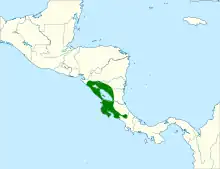Blue-vented hummingbird
The blue-vented hummingbird (Saucerottia hoffmanni) is a species of hummingbird in the "emeralds", tribe Trochilini of subfamily Trochilinae. It is found in Costa Rica and Nicaragua.[3][2]
| Blue-vented hummingbird | |
|---|---|
 | |
| Scientific classification | |
| Domain: | Eukaryota |
| Kingdom: | Animalia |
| Phylum: | Chordata |
| Clade: | Dinosauria |
| Class: | Aves |
| Clade: | Strisores |
| Order: | Apodiformes |
| Family: | Trochilidae |
| Genus: | Saucerottia |
| Species: | S. hoffmanni |
| Binomial name | |
| Saucerottia hoffmanni | |
 | |
| Synonyms | |
|
Amazilia saucerottei hoffmanni[2] | |
Taxonomy and systematics
The blue-vented hummingbird was formerly placed in the genus Amazilia as a subspecies of the steely-vented hummingbird (then Amazilia saucerottei, now Saucerottia saucerottei). A molecular phylogenetic study published in 2014 found that the genus Amazilia was polyphyletic. In the revised classification to create monophyletic genera, most taxonomic systems accepted the blue-vented hummingbird as a separate species and moved it to the resurrected genus Saucerottia.[4][5][3][6][7] However, BirdLife International's Handbook of the Birds of the World (HBW) retains it as the steely-vented subspecies Amazilia saucerottei hoffmanni.[2]
Description
The blue-vented hummingbird is 8 to 11 cm (3.1 to 4.3 in) long and weighs an average of 4.45 g (0.16 oz). Both sexes have a straight bill with a blackish maxilla and a coral-red mandible with a dark tip. Adult males have golden-green upperparts with coppery to purplish rump and uppertail coverts. Their underparts are dark glittering golden-green with greenish to steel blue undertail coverts. Their tail is pale steel blue and slightly forked. Adult females are similar but with a duller green lower breast and belly. Their throat feathers have white bars near the end, the feathers of their vent area have grayish-buff edges, and their outer tail feathers have purplish tips. Juveniles are darker than adults and duller green below with a grayish-brown belly. Their throat is darkish gray and their back and rump feathers have brownish edges.[8]
Distribution and habitat
The blue-vented hummingbird is found from southern Nicaragua to central Costa Rica. It inhabits semi-open landscapes such as scrublands, savanna, the edges of mature forest, secondary forest, and gardens. It tends to prefer dryish habitats except in the dry season, when it is found in moister areas. In elevation it ranges from sea level to at most 1,800 m (5,900 ft).[8]
Behavior
Movement
The blue-vented hummingbird makes local movements, in part to follow flowering events.[8]
Feeding
The blue-vented hummingbird forages for nectar at a wide variety of plants, vines, shrubs, and trees. It tends to forage only as high as the tops of small trees and often defends feeding territories. In addition to nectar if feeds on insects that it captures on the wing and sometimes from the surface of water.[8]
Breeding
Almost nothing is known about the blue-vented hummingbird's breeding phenology except that its breeding season appears to span at least from December to April. It builds a cup nest of plant down and cobweb with lichen on the outside. One nest in Costa Rica was on a dead Cecropia branch and another on a Ficus vine.[8][9]
Vocalization
The blue-vented hummingbird's song is "a repeated buzzy, squeaky phrase tzi-tzee-tzup, sometimes followed by a few lower-pitched notes, tzi-tzee-tzup ... wut-chur-up." It also makes calls described as "a high, sharp tsit or dry chit, sometimes uttered in sputtering series."[8]
Status
The IUCN follows HBW taxonomy and so has not assessed the blue-vented hummingbird separately from the steely-vented hummingbird sensu lato.[10]
References
- "Appendices | CITES". cites.org. Retrieved 2022-01-14.
- HBW and BirdLife International (2021) Handbook of the Birds of the World and BirdLife International digital checklist of the birds of the world. Version 6. Available at: http://datazone.birdlife.org/userfiles/file/Species/Taxonomy/HBW-BirdLife_Checklist_v6_Dec21.zip retrieved August 7, 2022
- Gill, F.; Donsker, D.; Rasmussen, P., eds. (August 2022). "Hummingbirds". IOC World Bird List. v 12.2. Retrieved August 9, 2022.
- McGuire, J.; Witt, C.; Remsen, J.V.; Corl, A.; Rabosky, D.; Altshuler, D.; Dudley, R. (2014). "Molecular phylogenetics and the diversification of hummingbirds". Current Biology. 24 (8): 910–916. doi:10.1016/j.cub.2014.03.016.
- Stiles, F.G.; Remsen, J.V. Jr.; Mcguire, J.A. (2017). "The generic classification of the Trochilini (Aves: Trochilidae): Reconciling taxonomy with phylogeny". Zootaxa. 4353 (3): 401–424. doi:10.11646/zootaxa.4353.3.
- "Check-list of North and Middle American Birds". American Ornithological Society. August 2022. Retrieved August 9, 2022.
- Clements, J. F., T. S. Schulenberg, M. J. Iliff, S. M. Billerman, T. A. Fredericks, J. A. Gerbracht, D. Lepage, B. L. Sullivan, and C. L. Wood. 2021. The eBird/Clements checklist of Birds of the World: v2021. Downloaded from https://www.birds.cornell.edu/clementschecklist/download/ Retrieved August 25, 2021
- Weller, A.A., P. F. D. Boesman, and H. F. Greeney (2021). Blue-vented Hummingbird (Saucerottia hoffmanni), version 1.1. In Birds of the World (S. M. Billerman, B. K. Keeney, P. G. Rodewald, and T. S. Schulenberg, Editors). Cornell Lab of Ornithology, Ithaca, NY, USA. https://doi.org/10.2173/bow.buvhum1.01.1 retrieved September 6, 2022
- Feinsiinger, Peter (1977). "Notes on the Hummingbirds of Monteverde, Cordillera De Tilaran, Costa Rica". Wilson Bull. 89 (1): 159–164. Retrieved September 6, 2022.
- BirdLife International (2021). "Steely-vented Hummingbird Amazilia saucerrottei". IUCN Red List of Threatened Species. 2021. Retrieved 6 September 2022.